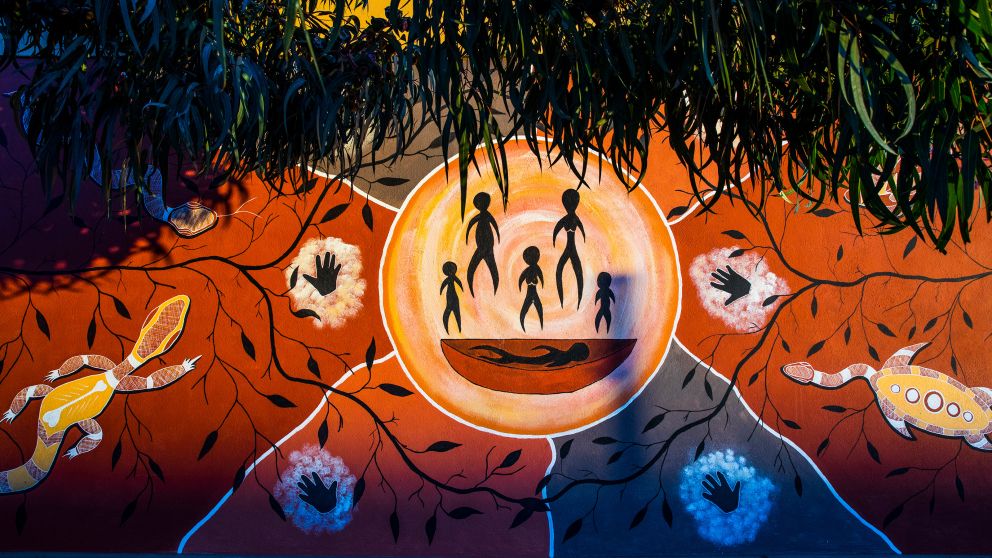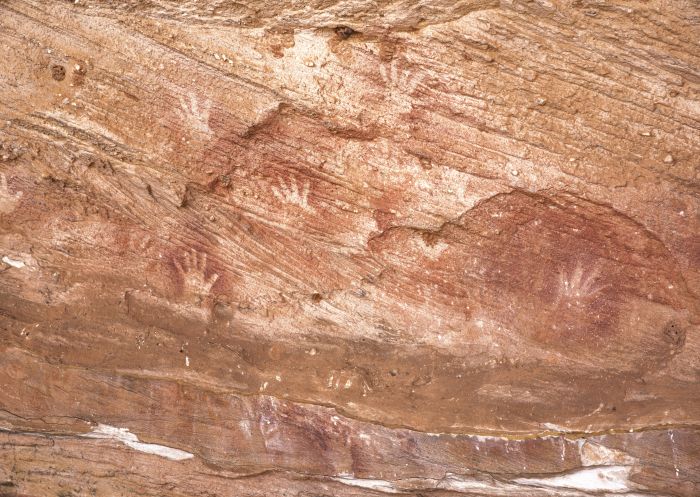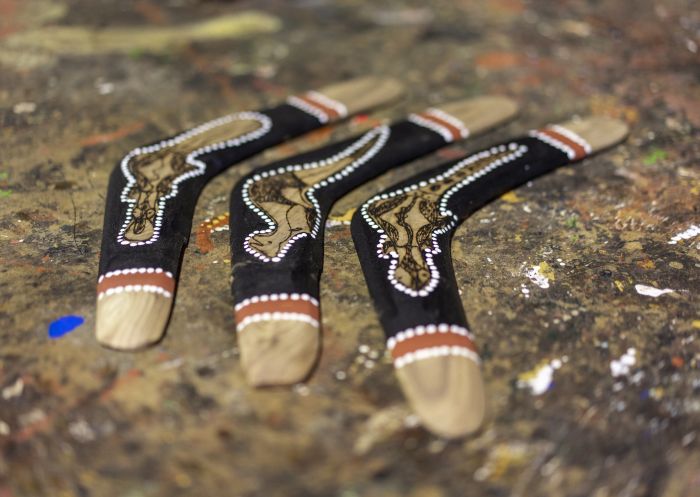

Aboriginal art in NSW
Eddie Harris Indigenous mural on the wall of the Maari Ma Building on Argent Street, Broken Hill.



Every piece of Aboriginal art tells a fascinating story. Whether rock art, sculptures or contemporary paintings, here’s how to witness the diversity of NSW’s Aboriginal art.

For millennia, NSW’s Aboriginal communities told their stories via drawings, paintings and petroglyphs on rocks. Remarkably, much of it remains today, and you can still glimpse it in national parks across the state.
Visit Mutawintji National Park, northeast of Broken Hill, to see hand stencils, a Groonki mark (stick figures said to symbolise a spiritually significant site), and a painting of a Yarra stick. Interpretive signs explain the details. Meanwhile in Gundabooka National Park near Bourke, jaw-dropping Aboriginal rock paintings depict animals, dancers, hand stencils and hunting tools.
A number of Aboriginal owned and operated companies offer tours that interpret rock art, as well as the Aboriginal connection to the land and wildlife. But there are plenty of opportunities to lace up your walking shoes and explore at your own pace.

Aboriginal rock art at Mutawintji National Park, Mutawintji
Public galleries and Aboriginal owned cultural centres across the state today showcase the evolution of Aboriginal art, from traditional landscapes on canvas to contemporary paintings and sculptures. On the Central Coast, Bouddi Gallery represents artists from not-for-profit Aboriginal-owned art centres in remote areas, showcasing an impressive collection of paintings on canvas and bark, carvings, ceramics, weavings and seed jewellery.
You can also learn the stories behind the works of some of Australia’s most celebrated Aboriginal artists at Broken Hill Regional Art Gallery, which houses important pieces by Clifford Possum Tjapaltjarri and Emily Kame Kngwarre, among others. And at the Dunghutti-Ngaku Aboriginal Art Gallery in Kempsey, you’ll find the artworks of weavers, sculptors and printmakers.
Along the mighty Murray River in Albury, in southwest NSW, you’ll find the Yindyamarra Sculpture Walk, a five-kilometre trail dotted with sculptures created by Aboriginal artists. Bring your smartphone to watch videos interpreting each creation as you go.
Learn the ancient signs and symbols of art with a clay modelling or boomerang painting class at the Yarrawarra Aboriginal Cultural Centre at Corindi Beach, just north of Coffs Harbour. The centre also hosts regular weaving circles, an art that you can also try your hand at with Explore Byron Bay in the north of the state.

Yarrawarra Aboriginal Cultural Centre, Corindi Beach - Credit: Yarrawarra Aboriginal Cultural Centre
Aboriginal art is the longest continuing tradition in the world – it’s important to ensure you purchase art ethically, to sustain the tradition for future generations and ensure that any money goes back to the artist or local community.
The first step in buying art is to find an Aboriginal owned or resonsible gallery, or art dealer, preferably one that specialises in Aboriginal art. Check if they are a member of the Indigenous Art Code. If so, you know they have signed the Indigenous Art Commercial Code of Conduct.

Couple discussing art works, Bank Art Museum (BAMM), Moree
Secondly, it’s time to speak up. Ethical galleries and dealers should be more than happy to answer your questions, from what share of the sales price goes back to the artist to how the gallery acquired its works. Other key questions include: Who is the artist, where are they from, and under what conditions do they work? It’s about fairness and transparency.
Next, ensure the artwork is authentic. A Certificate of Authenticity should include the artist’s name, title of the work, date or year painted, language group or nation and sometimes an artist’s statement. The Indigenous Art Code advises that any piece of Aboriginal or Torres Strait Islander art bought for more than $250 at an art centre should come with an authentication certificate.

Sandhills Artefacts, Narrandera - Credit: Narrandera Tourism
Of course, you can also buy directly from the artist. If you do so, be respectful, don’t barter for price and understand this may be their main source of income.
Most importantly, enjoy the experience, and realise that your purchase has helped ensure that sacred kinship ties and the passing of knowledge remain unbroken for generations to come.
Subscribe to our newsletter in order to stay up to date for all the upcoming events, news and inspiration.
Never miss out on news and events
All the insider news, tips and inspiration you need to plan your next trip, delivered straight to your inbox.
Sign UpVisitNSW.com is the official tourism site for Destination NSW.
© Copyright 2024 Destination NSW. All rights reserved